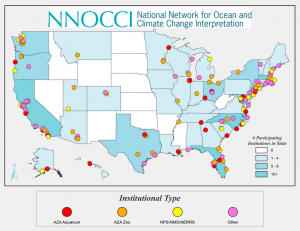Climate Science for All: NNOCCI Strategies to Improve Climate Communications
Fight, flight, or freeze: these are human’s three natural reactions to encountering a perceived threat. But what if the threat was amorphous, seemingly far off, and highly misunderstood? How might we react then? As demonstrated by the FrameWorks Institute in their ‘on the street’ climate interviews—see The Value of Explanation research report—the majority of US Citizens demonstrate a general lack of clarity on what climate and ocean change is, what’s causing it, or how to tackle the issues presented by it. Whereas most people could tell you to avoid poking a hornet’s nest, even if they have never been stung by one, there is a swamp of misunderstanding that precludes most US citizens from even engaging in discussions on climate solutions. Even if those same people are already experiencing the effects of climate and ocean change, their lack of knowledge on the subject (perceived or otherwise), often prohibits them from speaking on the matter, hence ensconcing them in a spiral of silence.
But there is hope for change. A recent NPR article shared insight that the vast majority of US parents want their children to be taught about climate change in school, even if most schools are not tackling the issue in their coursework. This is why groups like the National Network for Ocean and Climate Change Interpretation (NNOCCI) are so important, as they provide tools to aid informal science education centers in conducting these pivotal discussions. Since 2012, NNOCCI has worked with a multitude of experts in climate science, linguistics, and analysis, to bring these conversations to life. The lessons learned from this powerful program provide a great deal of insight on how educators of all types can tackle these complex issues with greater efficacy.
Lessons Learned: NNOCCI Strategies to Improve Climate Communications
Clearly Convey the Difference Between Weather and Climate
Fundamentally, there is a lot of cognitive dissonance between weather and climate. Weather can change by the instant, but climate patterns change over many years. This understanding shifts the discussion of climate change away from just one or two days of atypical weather in any given city to shifting baselines from historical climate records and the increased frequency of ‘historic’ weather events all around the world.
Effectively Frame the Conversation
On an international stage, expanded conversations regarding the anthropogenic mechanisms of climate change are often met with fear mongering, an overabundance of data, misinformation and finger pointing. With this much disparity, drawing communal decisions becomes increasingly more conflicted, and so it comes as no surprise that, like evolution, climate change has become a hot-button topic for the classroom. Although 70% of US citizens feel a desire to talk about it, their fear of alienation ultimately means they are more likely to choose silence, which only begets further silence. Therefore, it is important to remember that every piece of communication has its own tone and set of values, whether we intend to portray them or not. Strategically framing conversations to be positive and solutions focused leads to better chances at engaging dialogue. Here is a deeper dive into some of these ideas:
- Lead with Values: When we appeal to preservation for ourselves, and future generations, we are more likely to engage others in these important discussions. FrameWorks has taught us that we achieve greater success when we impart the values of ‘responsible management’ and ‘protection’ in our climate communications.
- Make It Inclusive: Bottom line, the issues we face with climate and ocean change are greater than any individual person, and so the tone and word choice we employ must much the scale of the issue. Climate change is an issue that affects us all, and therefore, we must employ communal strategies to tackle these global problems. When discussing a changing climate, it behooves us to speak inclusively, by focusing on the ‘we’, rather than the ‘they’, or ‘you’.
- Focus on Hope, Instead of Fear: Intoning a sense of crisis will not help move the conversation forward but instead cause confusion and fear which often leads to inaction. Leading with “traps”, like crisis or focusing on the plight of one adorable polar bear, we pigeonhole our conversation. Instead leading with open dialogue, focused on hope and honesty, others get a sense of autonomy within their community, which is necessary to encouraging action.
Make the Science ‘Sticky’
FrameWorks linguistic analysis allows us to see that presenting science in a ‘sticky’ way—a way in which complex scientific principles are distilled into tangible concepts through metaphors—allows the average citizen to garner a greater sense of understanding on what is causing climate change, and how they can take steps to effect change. Like the climate vs. weather confusion discussed above, many US citizens do not know that climate change is caused by rampant levels of carbon dioxide being released into the atmosphere. Comparing the gasses to a heat trapping blanket as an explanatory metaphor more easily distills the phenomenon into a relatable concept.
Focus on Solutions
In the story of Chicken Little, the adage about a little chick who warns the townspeople that the sky is falling, none can say that he lacked action, but did he provide any semblance of solution to his proposed problem? If Chicken Little had tomes of research that validated his claim that the sky was falling, and he presented this to the townspeople, would that have helped his cause, or just created more fear and inaction? Solutions are an integral part of our climate story that must be harkened back to time and again if we seek change. As climate and ocean change are problems that are bigger than any one individual, so too are the solutions. Thinking beyond ourselves, and our research, while fostering a sense of community brings light to the solutions that are already proving beneficial.
Ready to Change the Conversation on Climate and Ocean Change?
The FrameWorks Institute, in partnership with NNOCCI, created a free online course, which can help you dive deeper into the topics discussed in this blog post. Similarly, NNOCCI has worked with a multitude of informal science education centers across the country, to train educators on these important climate communication topics.

The map shows the 170 institutions, across 38 states, who have worked with NNOCCI to better their climate communications.
You can check out NNOCCI’s partner website, ClimateInterpreter, for a map of the 170 institutions, across 38 states, who have worked to better their climate communications through this important work. While there, you can discover more resources on how to best frame your climate communications, learn about potential trainings, as well as gain access to a platform of like-minded people, where you can share questions and resources. While climate communications can feel daunting, talking about our issues is the first step in rectifying them. There is a community of others, ready and willing to fight alongside you, for a carbon-free future; we are not alone.
“If I am not for myself who is for me? And being for my own self, what am ‘I’? And if not now, when?” – Hillel the Elder



This guest blog is a collaboration of NNOCCI, Urban Waters Learning Network, and River Network.
This post originally appeared on the UWLN website.
If you have practical knowledge and experience related to climate communications, addressing climate risk, and intersections with water security, consider presenting your work at River Rally 2020! This year, we have a new workshop theme: Addressing Climate Risk for Greater Water Security. Learn more about the submission process, themes, and submit your proposal today by clicking here.





